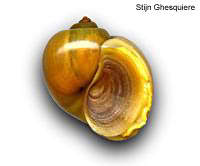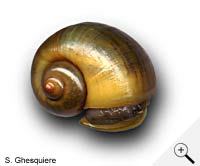
(Lamarck, 1819)
 |
(Lamarck, 1819)
|
The South American ampullarid Pomacea canaliculata is classified under the canaliculata complex. This is a groups af very closely related species which are very variable in size and appearance. In particular, it can be mistaken for Pomacea insularum.
Shell: The shell of this apple snail
species is globose and relatively heavy (especially in older snails). The 5
to 6 whorls are separated by a deep, indented suture (hence the name 'canaliculata'
or 'channeled'). The shell opening (aperture) is large and oval to round. Males
are known to have a rounder aperture than females. The umbilicus is large and
deep. The overal shell shape is similar to that of Pomacea lineata, except
the deeper sutures and more globose shape in canaliculata.
The size of these snails varies from 40 to 60 mm wide and 45 to 75 mm high depending
on the conditions.
The colour varies completely yellow and green (cultivated forms) to brown with
or without dark spiral bands (wild form). The shell growth of this species occurs
mainly in spring and summer, while it stagnates in fall and winter.
|
Interactive 3D-models (Java): |
Operculum: The operculum is moderately thick and corneous. The structure
is concentric with the nucleus near the centre of the shell. The colour varies
light (in young snails) to dark brown. The operculum can be retracted in the
aperture (shell opening).
Body: The colour of the body varies from yellow (cultivated), brown to
nearly black, with yellow spots on the siphon, but not as much on the mouth
as in Pomacea diffusa.
When at rest, the tentacles are curled under the shell.
 Brown Pomacea canaliculata snail. |
 Yellow Pomacea canaliculata snail. |
 Pomacea canaliculata shell and operculum. |
 Brown Pomacea canaliculata snail, depositing eggs. |
 Yellow Pomacea canaliculata snail. |
 Typical deep, indented sutures of Pomacea canaliculata. |
Reproduction: Pomacea canaliculata is sexual mature at the
size of 2.5 cm/1 inch.
The reproductive rate of this snail varies with the temperature and partly by the
availability of food.
During fall and winter, the reproduction rate is at its lowest point, while with the
raising temperatures in spring their reproduction rate increases.
Eggs: The reddish (due to the high carotenoid content) eggs are loosely
attached to each other. They are attached on object above the waterline and
their size varies from 2.20 to 3.5 mm (0.09 to 0.14 inch) diameter. An average
clutch contains 200 to 600 eggs.
 Pomacea canaliculata depositing the eggs on a trunk. Argentina. (picture not licenced under creative commons) |
 Eggs of the non-native Pomacea canaliculata on a rock at the border of the Kranji Reservoir, Singapore (12/9/2000). Note that the bright orange colour is hidden by the dry surface. (picture not licenced under creative commons) |
 Eggs, Pomacea canaliculata, a few hours after deposition. |
|
Food: Eats almost all types of plants; can also be fed with fish food;
isn't suited for planted aquaria at all; to be avoided unless you don't have
plants or other vegetation in your aquarium.
Behaviour: amphibious animal; submerged during the day, hidden in the
vegetation near the border and the surface. More active during the night, also
leaves the water in search for fresh vegetation.
The activity rate of this snail varies highly with the water temperature. Below
18°C they hardly move around, this in contrast with higher temperatures (25°C).
Nevertheless, Pomacea canaliculata is more resistant
to lower temperatures than most other snails from the genus Pomacea.
 Natural habitat of Pomacea canaliculata in the province of Buenos Aires, Argentina. (picture not licenced under creative commons) |
Habitat and distribution: Pomacea canaliculata is widely distributed
in the lentic habitats throughout the Amazon Inferior Basin and the Plata Basin:
Southeast Brazil, Argentina, Bolivia, Paraguay and Uruguay. Pomacea canaliculata
is one of the most Southern occuring Pomacea species in South America
(Argentina).
Last decades Pomacea canaliculata has spread to south-east Asia and can
now be found in Indonesia, Thailand, Cambodia, Hong Kong, southern China, Japan
and the Philippines. The snail also invaded in the Southern parts of the USA
(Texas and Florida, upto central Ohio) and is expected to spread futher in the
comming years. For more detailed information about the establishment of Pomacea
canaliculata populations in Texas, follow this link: http://www.cdfa.ca.gov/phpps/ppd/Entomology/Snails/Applesnail.htm
Possibly the species is making its way to Australia too.
![]() 'Pest Alert'
section, 'Asian
distribution map' section and 'Eradication'
section.
'Pest Alert'
section, 'Asian
distribution map' section and 'Eradication'
section.
Pomacea canaliculata is also a very common in the aquarium trade, but
its voracious appetite gives the apple snail family in general a bad reputation
in the aquarium hobby.
Looks similar to:
Pomace canaliculata looks very similar to some other members of the canaliculata
complex like Pomacea insularum
and Pomacea lineata.
|
Except where otherwise noted, this page is licensed under a Creative Commons Attribution-NonCommercial-ShareAlike 2.5 License . http://www.applesnail.net |
|